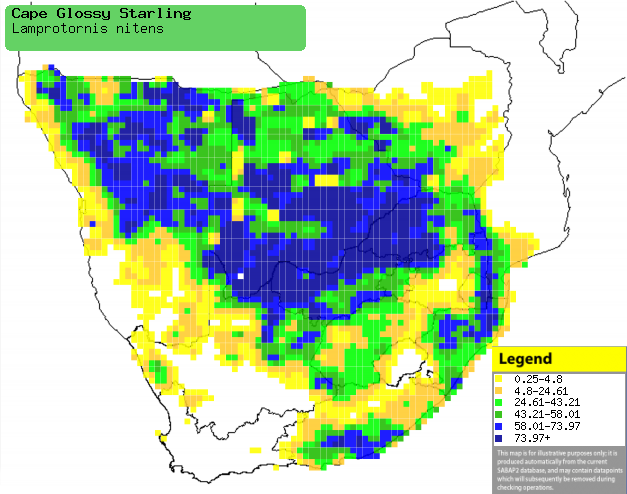|
Lamprotornis nitens (Cape Glossy
starling, Glossy starling)
Kleinglansspreeu [Afrikaans]; Inyakrili, Inyakrini
[Xhosa]; iKhwezi, iKhwinsi (generic terms for glossy starlings) [Zulu]; Ndjundju
(generic term for starling) [Kwangali]; Leholi-piloane [South Sotho]; Legodi
[North Sotho]; Hwirigwiri (generic name for glossy starling) [Shona]; Likhweti
[Swazi]; Kwezu leri tsongo (also applied to Greater blue-eared starling)
[Tsonga]; Legôdi (also applied to Greater blue-eared starling), Leswędi
[Tswana]; Roodschouder-glansspreeuw [Dutch]; Choucador ŕ épaulettes rouges
[French]; Rotschulter-glanzstar [German]; Estorninho-metálico [Portuguese]
Life
> Eukaryotes >
Opisthokonta
> Metazoa (animals) >
Bilateria >
Deuterostomia > Chordata >
Craniata > Vertebrata (vertebrates) > Gnathostomata (jawed
vertebrates) > Teleostomi (teleost fish) > Osteichthyes (bony fish) > Class:
Sarcopterygii (lobe-finned
fish) > Stegocephalia (terrestrial
vertebrates) > Tetrapoda
(four-legged vertebrates) > Reptiliomorpha > Amniota >
Reptilia (reptiles) >
Romeriida > Diapsida > Archosauromorpha > Archosauria >
Dinosauria
(dinosaurs) > Saurischia > Theropoda (bipedal predatory dinosaurs) >
Coelurosauria > Maniraptora > Aves
(birds) >
Order: Passeriformes
> Family: Sturnidae
> Genus: Lamprotornis
Distribution and habitat
Occurs from Angola and Zambia to southern Africa, where it
is locally common across much of the region, excluding central Mozambique, the
Karoo, Namib Desert and the fynbos biome in the Western Cape. It can occupy a
variety of different habitats, especially wooded savanna, forest edges, riverine
bush, plantations, parks and gardens.
|
 |
|
Distribution of Cape glossy starling in southern Africa,
based on statistical smoothing of the records from first SA Bird Atlas
Project (©
Animal Demography unit, University of
Cape Town; smoothing by Birgit Erni and Francesca Little). Colours range
from dark blue (most common) through to yellow (least common).
See here for the latest distribution
from the SABAP2. |
Predators and parasites
It has been recorded as prey of the following birds:
Brood parasites
It has been recorded as host of the
following birds:
Food
It eats insects, fruit, nectar and scraps of human food,
doing most of its foraging on the ground, running and hopping in search of food
items. It often associates with antelope, removing ectoparasites from them as
well as catching the insects they disturb. The following food items have been recorded
in its diet:
- Plants
- fruit
- Azima tetracantha (Needle bush)
- Lycium (honey-thorns)
- Rhus (currants)
- Olea (olives)
- Scutia myrtina (Cat-thorn)
- Diospyros dichrophylla (Poison-peach)
- Atriplex semibaccata (Creeping saltbrush)
- Ficus (wild figs)
- nectar
- Aloe
- A. candelabrum (Candelabra aloe)
- A. greatheadii (Spotted aloe)
- A. ferox (Bitter aloe)
- A. marlothii (Mountain aloe)
- A vanbalenii (Pongola aloe)
- Boscia albitrunca (Shepherds-tree)
- Erythrina caffra (Coral-tree)
- Protea subvestita (Lipped protea)
- Invertebrates
Breeding
- It is a monogamous, cooperative breeder, meaning that the breeding pair
may be assisted by up to 6 helpers, who often remain with them through many
breeding seasons.
- It usually nests in tree cavities, either natural or excavated by
woodpeckers or
barbets, but it may also use a hole in a
riverbank, metal pipe or even a post box used daily. It adds coarse material
such as twigs into the cavity until the platform is close to the entrance,
after which it adds a lining of dry grass, dung and snake skins. It often
uses the same nest over multiple breeding seasons, in fact one breeding pair
was recorded using the same site for 20 years.
- Egg-laying season is mainly from September-February.
- It lays 2-6 eggs, which are incubated solely by the female.
- The chicks are fed by both parents and helpers, leaving the nest after
about 20 days after which they remain with the group for at least week.
Threats
Not threatened.
References
-
Hockey PAR, Dean WRJ and Ryan PG 2005. Roberts
- Birds of southern Africa, VIIth ed. The Trustees of the John Voelcker
Bird Book Fund, Cape Town.
|
